350 Search Results for aided language input
March 28, 2016
by Carole Zangari -

A growing number of clinicians, families, and educational teams are prioritizing the use of aided language input as a foundational strategy for AAC learners. When we first started writing about this strategy, it was rare to see adults using AAC to talk with AAC learners.Consistent implementation is still a challenge, but more and more of you are speaking AAC to teach AAC. And quite of few of you are doing your best to influence other stakeholders to support augmented communicators in this way. If you are doing inservices, teaching classes, or guiding teams toward better AAC intervention, the videos listed below may be useful to you in those efforts. Chris Bugaj developed this clear and engaging cartoon explaining the concept for people new to this strategy. Caroline Musselwhite recorded a full webinar with detailed information on aided language input. Communicare, a clinical practice with a strong focus on AAC,... [Read More...]
February 18, 2016
by Carole Zangari -

When you have a chance to peek into a therapy session by a master clinician, take it! In today’s featured video, Gail Van Tatenhove shares a clip where she demonstrates use of a pivotal intervention strategy, aided language input, as they discuss a book. Among many other things, Gail is author of one of our favorite therapy tools, The Pixon Project Kit. Enjoy! Direct link to video: https://www.youtube.com/watch?v=QywUaX99-D4
September 9, 2015
by Carole Zangari -

There is a short list of presenters that I like go see, no matter what topic they are speaking on. Dr. Caroline Musselwhite has been on that list for a very long time. In this video, she provides an insightful discussion of a pivotal intervention strategy, aided language input. If you appreciate hearing from clinicians who have been doing this work for many years, you will love this engaging and prAACtical presentation. You can get the accompanying handouts here and here. Please note that you will need to register in order to view the presentation. Many thanks to the Angelman Syndrome Foundation for making this available. Direct Link to Video: https://attendee.gotowebinar.com/recording/7139066695959986690
December 21, 2014
by Carole Zangari -

How do you incorporate aided language input while reading books? There are lots of ways to do it. Here’s one of them.
November 16, 2014
by Carole Zangari -

It’s a great day to see AAC strategies in action. Today, the AAC Chicks from Dynamic Therapy Assoiates are back with another prAACtical video about using aided language input in conversation. You can see more of their work here. Direct link to video: https://www.youtube.com/watch?v=PUl8kD53NQg
March 13, 2014
by Carole Zangari -
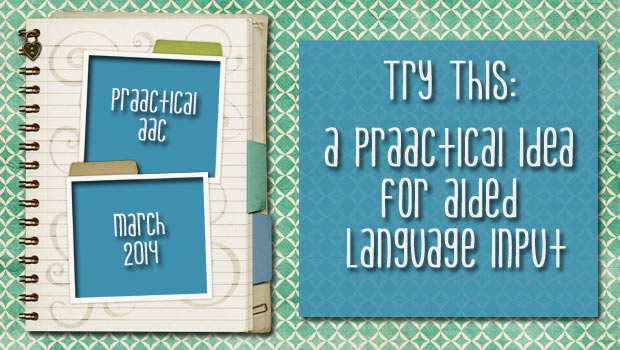
At the ATIA 2014 conference in January, it was exciting to hear about the updates on how core vocabulary is being addressed in the alternate assessment project for Dynamic Learning Maps. Allison Dennis, Dr. Karen Erickson, and Dr. Penny Hatch, of the Center for Literacy and Disability Studies, shared a lot of interesting information, as you can see from their handout. One of my favorite ‘take-aways,’ though, was a suggestion by Karen Erickson regarding the importance of aided language input for students with significant disabilities. We’ve written about aided language input so often that you may be tired of hearing it, but bear with us because her suggestion was pure genius. Ready? Here it is: List aided language input as an accommodation in the IEP. Why List Aided Language Input as an IEP Accommodation? It is a fundamental strategy for any beginning learner of AAC. It is rarely implemented... [Read More...]
January 27, 2014
by Robin Parker -
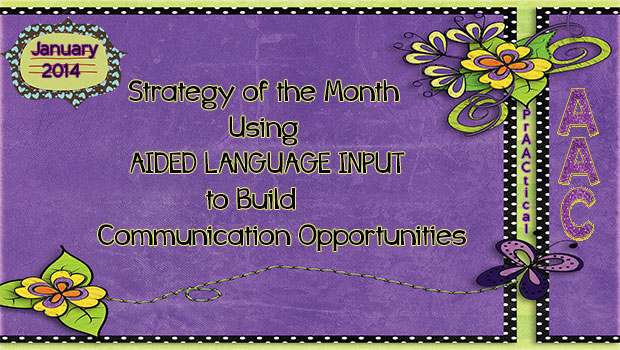
We can not write, speak or do enough Aided Language Input (ALI). If we expect learners to speak AAC, we must speak AAC to them. It is difficult enough to learn a language and imagine if no one spoke it to you in the language you were expected to speak…But there are so many more reasons to do ALI. Aided Language Input (ALI) belongs in the context of communication opportunities. It is modeling AAC style. Once we model a target language concept AAC style, then add the wait and signal strategy, the learner then knows it is their communicative turn. Especially if you wait with the raised eye brow signal. They often will take their turn expressively. But, if they do not take the communicative opportunity to take their turn, there are gestural, visual, verbal, and physical prompts that can be implemented. In other words, they can make use of... [Read More...]
October 3, 2013
by Carole Zangari -
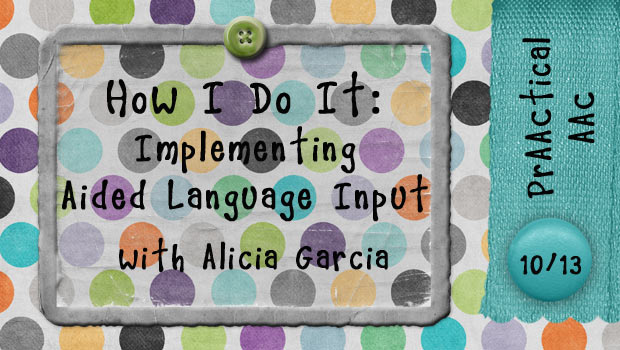
We are so pleased to have reconnected with SLP Alicia Garcia and are even more delighted that she agreed to do a guest post. Alicia is the clinical lead of the AAC Clinic at One Kids Place, a children’s treatment centre in northern Ontario. She has over 20 years of experience in pediatric rehabilitation practice in private and public settings, including clinical practice in AAC clinics and programs in Wisconsin, Florida, and now in Ontario. In this post, Alicia addresses one of our favorite clinical strategies in a very prAACtical way. Implementing Aided Language Stimulation: 8 Frequent Mistakes and How to Avoid Them Aided Language seems like a simple concept: Partners should model or demonstrate picture communication when talking to children who are learning to use picture communication, so that they would learn by example. Yet, when it comes to implementation we see frequent mistakes and misinterpretations. The most commons being:... [Read More...]
August 11, 2013
by Robin Parker -
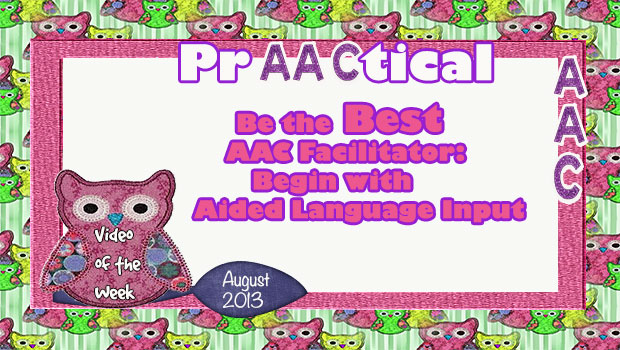
Use Aided Language Input (ALI). If you have never have worked with a student with AAC, are just beginning, or are an expert, one of the best AAC teaching strategies is ALI. Learn or refresh your ALI knowledge with this great video by One’s Kid Place: Children’s Treatment Centre.
June 27, 2012
by Carole Zangari -
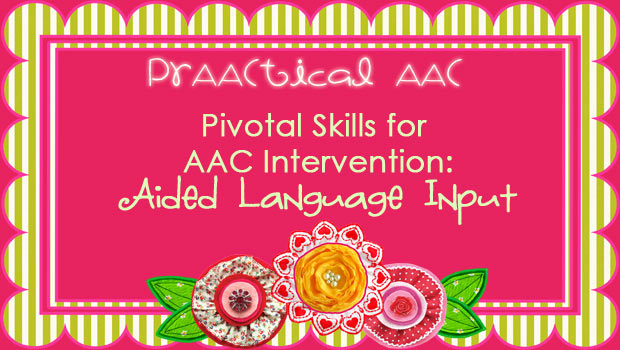
We can’t seem to stop talking about the power of aided language input. It’s one of those strategies that make our sessions more effective and make our clinicians more comfortable with the learner’s AAC system. And when other team members see us using it, they can’t help but pick up on the importance of aided modeling for people who are still learning to use their communication boards, books, SGDs, and mobile devices. – Modeling, AAC Style (clinical rationale, research supports) AACtual Progress: Learning to use Aided Language Input (lessons learned) Strategy of the Month: Aided Language Input (screencast overview) Using the Device/App: Getting the Team on Board (implementation) Teachers in AACtion: Aided Language Input (video) Why We Love Aided Language Input (clinical rationale) Curated Resources for Aided Language Input (miscellaneous info, videos) Video of the Week: Aided Language Input Demo (video) 5 Tools to Make Aided Language Input Easier –









